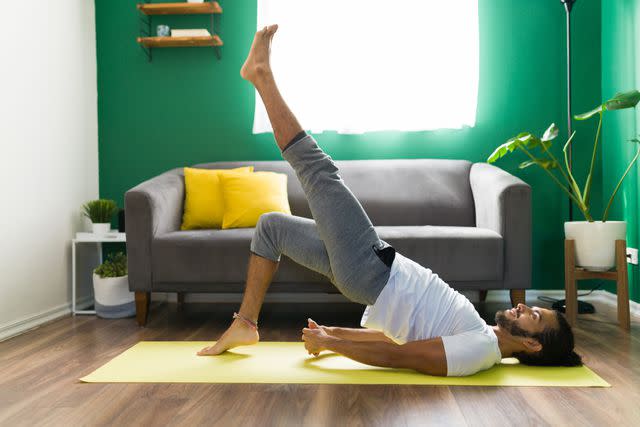Gout-Friendly Exercises to Meet Your Physical Goals
Medically reviewed by Katrina Carter, DPT
Gout, also called gouty arthritis, often causes painful, inflamed joints that can limit your ability to be physically active. While it may seem counterintuitive, regular physical activity, especially low-impact exercise like walking or cycling, can improve your gout symptoms.
This article will review the benefits of exercises for gout and exercises to avoid.

Antonio_Diaz / Getty Images
How Exercise Benefits Gout
Gout is an inflammatory form of arthritis caused by increased uric acid levels that damage joints and tendons. If left untreated, gout can lead to irreversible joint damage and chronic pain. Lifestyle changes, including diet and exercise, are key for managing gout.
Research suggests that exercise has an anti-inflammatory effect on the body and that regular exercise can help lower uric acid levels. This can help lower the risk of gout flare-ups and decrease pain.
People who have gout and remain physically active have fewer flare-ups per year and overall decreased pain compared to those who are not physically active.
Types of Activities to Try
Low- and moderate-impact activities are recommended to reduce stress at painful joints. Whole-body movements like brisk walking, cycling, and tai chi are good options that are easy to do every day. Gentle stretches and mobility exercises for your joints can decrease or prevent joint stiffness, which can help you move better.
How Exercise Worsens Gout Pain
While regular exercise and physical therapy can help improve pain and inflammation from gout, sometimes exercise can make symptoms worse. Certain movements can be irritating to your joints and may increase your pain.
During Flares
Gout flare-ups are characterized by a sudden onset of joint inflammation, pain, and swelling. During gout flares, it is best to avoid repetitive movements of affected joints. While exercise and movement is generally beneficial for your joints, they can increase pain during gout flares when joints are red, hot, swollen, and painful.
During gout flare-ups, it’s best to rest. Applying ice to your affected joints and taking pain medication can also help manage your symptoms until the flares resolve.
Gout flares can lead to disability and loss of function over time. If you are experiencing a gout flareup, don’t push yourself to exercise. It’s better to rest and let your symptoms ease. Stressing your joints during a flare can make pain and inflammation worse, and can sometimes lead to permanent joint damage.
Takeaway
Gout most commonly affects the big toe, so staying off your feet can help alleviate pain. Avoiding prolonged standing and walking as much as possible can help lessen your symptoms during a gout flare, especially if your ankles or knees are also affected.
Read Next: How to Quickly Relieve Gout Pain
High Impact
High-impact exercises can be stressful on the joints, which can increase joint irritation and pain. High-impact exercises also do not have the same beneficial effect on lowering levels of inflammation compared to low and moderate-impact exercises.
High-impact exercise is associated with a short-term increase in uric acid levels, which can worsen symptoms of gout. Movements to avoid include high-impact sports and running and jumping exercises.
Stretches and Exercises for Gout
Gout most commonly affects the big toe joint, but it can also affect the ankles, knees, and hands. Inflammation and pain can limit movement of these joints, so gentle mobility exercises that work on moving your joints through their full range of motion can help keep your joints healthy.
Examples of mobility exercises are:
Toe curls
Big toe extensions
Toe spreads
Ankle pumps
Ankle circles
In addition to mobility exercises, strengthening exercises can be helpful for gout. Strengthening muscles around your joints can help stabilize the joints. This can help keep them supported, and can prevent the strain from daily activities.
Examples of gentle strengthening exercises are:
Leg lifts
Bridges
Clamshells
Step-ups
Sit to stand
Heel lifts
Balancing Rest, Exercise, and Gout
Lifelong management of gout requires a careful balance between exercise and rest. Regular exercise should be a part of your weekly, or even daily, routine to stay healthy.
The Department of Health and Human Services (HHS) recommends 150 minutes of exercise per week. This can be achieved with 30 minutes of exercise per day for five days a week.
Low- or moderate-intensity exercise is especially beneficial to reduce uric acid levels with gout, which can help decrease inflammation and pain. Opt for exercises like walking, swimming, cycling, tai chi, and gentle strength training to avoid irritating your joints.
While high-intensity exercise can irritate joints and trigger or worsen gout flares, other triggers of gout flare-ups include drinking alcohol, smoking, and eating foods high in purines. When triggers occur and bring about gout flares, it’s important to rest your body to avoid further joint inflammation and pain.
Takeaway
In addition to regular low-impact exercise, managing your diet and taking medications to lower uric acid can help control your gout symptoms.
Summary
Too much exercise, or exercise that is too intense, can irritate joints and aggravate gout symptoms. Exercise, however, is part of maintaining a healthy lifestyle and is recommended to help reduce painful symptoms of gout and prevent flare-ups. Low- or moderate-intensity exercise, like walking, cycling, and tai chi, can benefit your body.
Avoid high-intensity exercise to decrease aggravating your joints. If you experience a gout flare-up, it is better to rest and avoid exercise until your pain and inflammation subside. If gout causes pain or inflammation in any of the joints in your legs or feet, staying off your feet and avoiding prolonged standing or walking can help ease discomfort.
Pain medication and ice can also help with symptoms until the flare resolves, and you can safely resume exercising.
Read the original article on Verywell Health.

